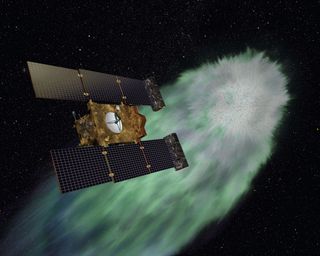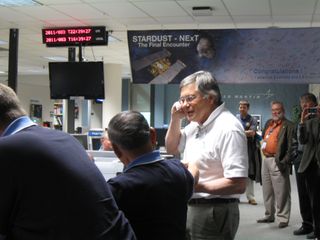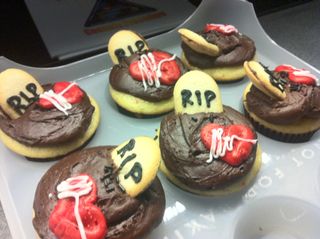Inside NASA's Space Funeral for the Comet-Hunting Stardust Probe

DENVER – It may seem funny to some that a lifeless collection of computers and cameras is worthy of a funeral. But when it came time to say goodbye to NASA's 12-year-old Stardust comet probe, scientists made sure the lights went out in style.
NASA shut down the Stardust spacecraft late Thursday (March 24) to end a prolific mission that visited an asteroid in 2002, collected samples from one comet in 2004, and then recycled itself to visit another comet earlier this year.
At about 7:30 p.m. EDT (2330 GMT), the mission planners commanded the four thrusters on Stardust to fire until the fuel ran dry – a final experiment to see what was left in the spacecraft's tanks after its 5.7 billion-mile (9.1 billion-kilometer) journey, and how it compared with estimates on the ground.
To the side of the room, Stardust technicians had scrawled their personal estimates of how much fuel remained on a board for all to see.
The real value was anybody’s guess, and the mood was palpable as many scientists prepared to say farewell to Stardust.
"One way to look at this … from now to a few billion years, Stardust can be happy, healthy and fine without all those pesky commands coming up," Don Brownlee, principal investigator for the Stardust mission from the University of Washington.
The spacecraft didn’t go down easy. The maneuver appeared to take longer to confirm than expected.
Get the Space.com Newsletter
Breaking space news, the latest updates on rocket launches, skywatching events and more!
As engineering data about Stardust’s condition reached computer screens, flight controllers presented a small rubber ball to Allan Cheuvront– Stardust program manager with the probe's builder Lockheed Martin Space Systems in Denver – in a tradition to relieve stress.
"Stardust's motors burned for 146 seconds," Cheuvront said later in a NASA statement. "We'll crunch the numbers and see how close the reality matches up with our projections. That will be a great data set to have in our back pocket when we plan for future missions." [How NASA's Stardust Comet Mission Worked]

A comet success story
NASA's Stardust mission was a true comet success story. The $300 million spacecraft launched in 1999 to retrieve samples from the comet Wild 2 (pronounced "Vilt 2"). On the way, it swung by the asteroid Annefrank to snap close-up pictures.
By 2004, Stardust caught up with comet Wild 2 and snatched up samples of the icy wanderer in a capsule that it dropped back on Earth in 2006.
Then NASA gave Stardust new marching orders: go meet another object, the comet Tempel 1, which NASA's Deep Impact spacecraft visited in 2005 and hit with an impactor to see what it was made of. The new $29 million mission was called Stardust-NExT.
Stardust flew by comet Tempel 1 on Feb. 14 of this year and beamed back stunning new images, including some that revealed for the first time the artificial crater created by the Deep Impact crash.[Photos of Comet Tempel 1 from NASA's Stardust]

Farewell Stardust
As Stardust's systems flat-lined last night, Cheuvront conducted one final poll among his team members, asking for the final state of subsystems, such as power, attitude control, thermal and navigation.
Each reported what their monitors last indicated as Stardust slipped away silently into the depths of space.
"This kind of feels like the end of one of those old western movies where you watch the hero ride his horse towards the distant setting sun — and then the credits begin to roll," said Stardust-NExT project manager Tim Larson from NASA's Jet Propulsion Laboratory in Pasadena, Calif. "Only there's no setting sun in space."
While the end of Stardust's mission had a sad note for some, NASA did have some treats prepared to lighten the mood. Cookies and cupcakes marked with R.I.P. were reportedly on hand during a "wake" following the end of the mission.
Once the last poll was complete, the Stardust's finale had arrived.
"At this time we say goodbye to a good friend. It is safe to say that Stardust is happy, healthy and fine," Cheuvront said. "All stations, we’re going off net now."
Leonard David has been reporting on the space industry for more than five decades. He is past editor-in-chief of the National Space Society's Ad Astra and Space World magazines and has written for SPACE.com since 1999.
Join our Space Forums to keep talking space on the latest missions, night sky and more! And if you have a news tip, correction or comment, let us know at: community@space.com.

Leonard David is an award-winning space journalist who has been reporting on space activities for more than 50 years. Currently writing as Space.com's Space Insider Columnist among his other projects, Leonard has authored numerous books on space exploration, Mars missions and more, with his latest being "Moon Rush: The New Space Race" published in 2019 by National Geographic. He also wrote "Mars: Our Future on the Red Planet" released in 2016 by National Geographic. Leonard has served as a correspondent for SpaceNews, Scientific American and Aerospace America for the AIAA. He has received many awards, including the first Ordway Award for Sustained Excellence in Spaceflight History in 2015 at the AAS Wernher von Braun Memorial Symposium. You can find out Leonard's latest project at his website and on Twitter.
